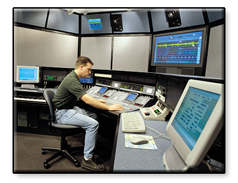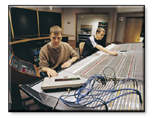Digidesign Website - August 2000
by Randy Alberts

"About eight years ago, one of our instructors was one of the first people in Arizona to receive a Pro Tools system," recalls Conservatory administrator Kirt Hamm.

"If a person wants to work in the audio industry, we're their best chance to get educated and go out to work in the industry."
The Conservatory is the largest — and only — Avid Authorized Education Center (AAEC) teaching both Pro Tools Courses 135 and 235 in the world. Meeting strict Digidesign-designed teaching requirements for curriculum and instructors alike, the real winners in Tempe are the students.
"Some non-accredited schools are teaching the 135 introductory course," says Kirt, "but we're the only school to teach it along with Digidesign's mix-intensive Pro Tools Course 235. Students leave here with certification from both Avid/Digidesign and the Conservatory that they have completed this coursework and are highly proficient and employable. If a person wants to work in the audio industry, we're their best chance to get educated and go out to work in the industry."
Students entering the Tempe campus embark on a 37-week audio adventure that includes Pro Tools tutelage and a full dose of recording fundamentals, the last seven weeks being devoted to a mandatory internship that every graduate completes — 98 percent of the Conservatory's enrollees graduate and become employed.
"As part of their graduation requirement, we have an internship program that every student has to do in order to graduate," Kirt says. "They prioritize five locations, then we contact those locations to tell the studios what each student's goal is and schedule them for 280 hours in a facility. Typically it leads to employment, either at that location or through our extensive networking process."
The school's Pro Tools studios recently added six new Pro Tools|24 MIXplus systems to ensure that each of the 12 students per classroom has the optimal personal workstation for 30 weeks. The Pro Tools studio equipment roster includes numerous 882|20 I/O and 888|24 I/O audio interfaces and SMPTE Slave Drivers connected to Apple Macintosh G4s, as well as the Waves Gold Bundle of TDM Plug-Ins.
"We also have a relationship with Waves that allows our students to leave with a Waves certification that demonstrates they have a deep understanding of how plug-ins interact with Pro Tools. We're the only school that's Waves-certified, and we're currently in discussions with Apogee Electronics about a similar program."
More than just a chalk-toting discipline for learning recording book knowledge, the Conservatory braves the fine line between cutting and bleeding edge technologies to best prepare their students for the real audio world of computer-based recording. The school opts to stay current with Digidesign's latest product releases to ensure backwards compatibility with older Pro Tools systems in use.
"There's a lot of facilities still using older Digi systems," says Kirt, "but we want to stay cutting edge because the older systems are easier to use if they (the students) understand the latest technologies. We've also extended their hands-on class time within the official Pro Tools coursework from 40 to 60 hours. No one in a studio control room is going to ask an intern, 'Please write down how to edit a drum track in Pro Tools'. They'll say, 'I need you to edit this drum track', and the intern has to perform immediately. Our course proficiency tests really enhance the hands-on nature of this kind of work, and it's ongoing through every phase of our curriculum."